#geological understanding
Explore tagged Tumblr posts
Text
Unveiling the West Swale: A Geological Odyssey Through Time

View On WordPress
#ancient ice sheets#ancient past#Chappell Marsh wetlands#crustal deformation#crustal uplift#dynamic geology#Earth’s crust#Earth’s crust dynamics#Earth’s history#Earth’s mantle#Earth’s surface#environmental impact#Environmental Impact Assessment#environmental preservation#erosion#flood management#geological evolution#geological exploration#geological features#geological forces#geological heritage#geological landmarks#geological legacy#geological narrative#geological observations#geological processes#geological study#geological study areas#geological systems#geological understanding
0 notes
Note
I'd pay so much money to hear you give a lesson on paleontolgy. Whenever you write about you seem so formal and passionate ✨️
this is sooooo sweet but i guarantee you don’t want this bc the first lesson would be on terminology and the geologic timeline, some of the most boring but fundamental shit 😭😭
or, hear me out—that but my feeder is stuffing me more and more. the lesson keeps getting interrupted by sips of weight gain shake and many belly rubs
#‘boring’ is relative btw#i hate how and why words work but i love the geologic timeline#i love how life has developed throughout all of it#and i love how a deeper understanding of that span of time truly changes your worldview#i see things as their path through time#idk if that makes sense but i see an oak tree and am just happy to know they’ve been around for like 40 million years#and i LOVE knowing what formations and areas fossils come from#one goal of mine is to have a piece of live oak fossil wood from the willis formation of southeast texas#it’d take some work to identify but god. i am willing#talk#ask
123 notes
·
View notes
Text
I'm wathing Rings of Power and can't help but compare certain scenes to minecraft biomes. Especially with caves.
The underground river awakening the volcano inside Mount Doom? 100% updated cave spawn I have traversed and got lost in multiple times.
Gnome king breaking through mountain to open this window to surface? classic minecraft experience, everyone have accidentally brocken through a wall when making house underground/in a mountain/hill.
p.s. In the first Hobbit movie there's also this vertical crack-like cave system with waterfalls that leads into a larger cave system/ valley between mountains - where have I seen this before
#lotr#trop#the rings of power#logically I understand that minecraft formations are based on irl geological formations#but also - this is fun
6 notes
·
View notes
Text
My church wasn't quite as hardcore on the anti-science stuff as many, but I still absorbed a lot of ideas I just never thought too hard about. Like, my mom definitely told me that all the 600 and 900-year old people in the Bible were because "people just lived longer back then" and I just... didn't really question it. I was a very scientifically minded child, but I just didn't ever think about the logic of it! It wasn't until I was in my late 20s that someone mentioned it and I went "... hang on, that is an absolutely bonkers idea, of course people can't live for centuries??"
I knew that as a kid, too... but I never connected the dots.
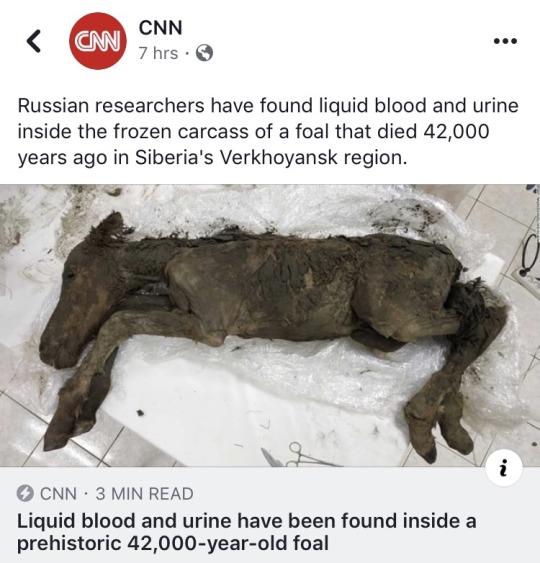

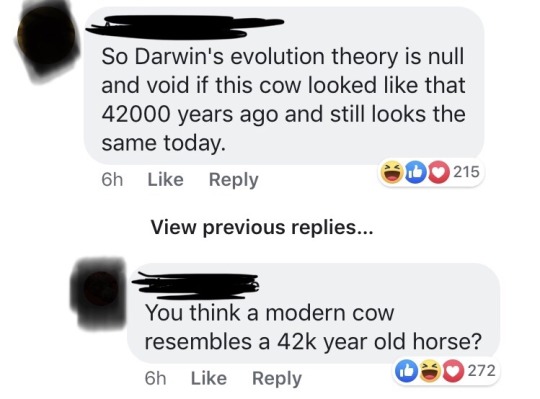



y’all I CANNOT
#Christianity#honestly geologic time is so hard to understand as is#65M years ago and 150M years ago feels like the same amount of time#it's not a real number#let alone BILLIONS#I kinda get why people can't grasp evolution
166K notes
·
View notes
Text
I know I'm asexual and I'm within a reasonable degree of certainty that I'm aromantic but I still feel like I have a pretty firm grasp on what is "hot" and what is "sexy" without those particular areas of attraction. Allow me to elaborate
An aesthetically or conceptually inspiring trait is "hot"
An aesthetically or conceptually inspiring ability is "sexy"
"Hot" is the appreciation for the theatre
"Sexy" is the appreciation for the zeitgeist
Something that is "sexy" is always "hot", but something that is "hot" is not always "sexy"
Things that are "hot", imo:
Antique wootz steel blades
A black 2020 Chevrolet Camaro
Eyeliner
Tongue piercings
Charlize Theron's voice
Things that are "sexy", possibly also "hot":
Martial arts
Pole dancing
Those video compilations of manual labour workers doing things nobody even thinks about super quick and efficiently
People who are really smart who study really specific stuff like geological chalk formations and shit
Things that are definitely "hot" and "sexy":
Being in a hardware store
A perfectly executed backflip
Good art that hits different
The sensation of drinking very cold water when you're really gross and hot and tired and it's like oooohhhhohohoho FUCK yeah
And finally, things that I'm reasonably sure are probably either "hot" or "sexy" that I still don't fully understand but am willing to take the L on:
Getting a massage (?)
Weiners
Football players, probably
Perfume commercials
[Redacted]
2K notes
·
View notes
Text
Literally every conversation with a colleague/peer in the academic field I'm in (anthropology, with a focus on human prehistory and human evolution) upon them learning I'm an observant religious Jew goes like this:
Person: "Sorry if this is a personal question, but how do you.... y'know......deal with it?"
Me: "Deal with what?"
Person: "Y'know...... y'know......your religion......"
Me: "Meaning?"
Person: "Well, um, how old do you believe the earth is?"
Me: "I follow the geological consensus, which is approximately 4.5 Billion years"
Person: "But......but.....your Bible says that it's 6,000 years old....."
Me: "Technically 5,783 years, so you're wrong there, haha"
Person: "Okay but how do you....how do you reconcile that with science?"
Me: "I don't need to reconcile it. They're not in opposition."
Person: "??"
Me: "The plain text in the Tanakh states that it has been 5,783 years since the creation of Adam, and consequently the world. Judaism has never been about taking the text in the Tanakh plainly, there's always deeper meanings. Who's to say that the 5,783 years aren't just the years since a couple named Adam and Eve met and copulated, triggering the begining of the lineage of Abraham, Moses, and the entire Jewish lineage, and that the six days of creation aren't six phases which are actually pretty in-line with our understanding of evolution?"
Person: "But.....some people believe that it's literally been 5,783 years since the earth was literally created!"
Me: "Okay..... that's what they believe. I don't see how it should bother me, especially considering we're in the field of anthropology where we try to study other patterns of belief, not cast judgement upon them."
Person: "But other Jews believe that!!!"
Me: "Again.....why should that affect my religious and academic senses of self? Judaism has never been a monolith of belief, anyway."
Person: "But-"
#for real it's so tiring#i literally could not give two shits what other people believe#and considering anthropology's history with mocking indigenous creation stories quite frankly you people should be doing better#anthropology#religion#judaism#personal
7K notes
·
View notes
Text

Yes... @lovedthestars-toofondly yes he would. Without understanding the reference. or that it's a reference.
Ken is of course one of the universe's natural Route Planners. In his Duke of Edinburgh expedition as a tiny baby Ken, his team role was Navigator (and of course they got gold.)
His orientation is so straight you can use him as a ruler. He's so steady that compasses point to HIM. He can even follow Charlie conversations. He likes ordinance survey maps, geological maps, and canal route planners (in fairness, those are easy - canals don't have a lot of junctions.)
So think it would be extra funny if he goes the fuck to pieces in London. Lost on the londerground. Absolutely fucked trying to get to the geolsoc library in fucking piccadilly where he is ironically going to look up a map. FUCK. HELP.

#killie#Charlie and Ken(dal Mint Cake)#i dont. i dont know why#on reflectiom#i dont know why he's wearing a buff.#i think he is overnighting and staying with a friend and he uses a buff as a mask on the tube
393 notes
·
View notes
Text
I was struck by how the entity’s growths formed in a spiral pattern, almost like a double helix you’d find in a strand of DNA. Oil is made from the fossilized remains of ancient plants and animals. It’s a sort of geological memory, just like how DNA is an evolutionary memory that allows the body to build and rebuild itself. And the primary thing that it affects when it touches people is their memories, whether random flashes of nostalgic images or deeply personally significant memories.
Going off of the DNA analogy…I don’t think the entity held any malice towards the crew. I don’t think it could hold malice to begin with, or goodwill, or any other more complex emotion. DNA is a chain of chemicals, and we have no conscious control over its transcription. The only thing it “wants,” as far as a chain of chemicals wants something, is to stay alive and to replicate itself. Its connection to oil also makes it feel like whatever dead, fossilized organic matter was trapped beneath the surface of the earth very mindlessly trying to return to life. The assimilated crewmates looked like cancerous lumps, growing out of control and endlessly dividing, not out of ill will, but because the cellular mechanism for growth had broken and was replicating out of control, only writ large, across the body of a whole person. The growths, like DNA writ large, a strand of chemicals trying to reassemble itself from whatever chemical matter from the rig and the crew it could use.
There’s a strange “humanity” to the entity, too, though in a very primal, instinctual sort of way. It wanted to be one with the rig and everyone on it, and it kept dredging up memories where Caz and the others felt especially close to their loved ones, even if they weren’t always happy ones. Caz, too, wanted to be one with his family again, but had that dream dashed by a selfish, individualist action. He wanted to keep his fellow crewmates together, and was increasingly devastated as assimilation or death cut them off from each other. The ending was beautiful, and felt like a barely comprehensible sort of kindness despite everything that had led up to it. For a moment, it felt like Caz reached an understanding with the force that had consumed him and that he in turn had destroyed, at least enough to forgive it and let go. In exchange, he got to relive the last time he and his wife were truly together, the morning he left for the rig. And then, over the empty ocean, we hear Suze’s tearful plea to Caz to come home, to reconnect with her, to be part of their family again. The letter felt like a summation of what Suze, Caz, and the entity itself wanted—to return home, to connect with others, to feel “whole” again.
987 notes
·
View notes
Text
Why Maud Pie is Autistic
In honor of Autism Acceptance Month, I wanted to write a piece about one of my favorite autistic characters, Maud Pie.

For those of you who don't know, Maud Pie is Pinkie Pie's older sister from My Little Pony: Friendship is Magic.

Now while there hasn't been any official confirmation that this character is autistic, there's actually a lot of hints that she is throughout her time on the show. Heck, in her first episode there's a ton of hints this is the case.
First off is that Maud tends to take a lot of things literally, not getting certain phrases and metaphors. Which is a trait common amongst autistic people (trust me, I know).

Maud is also shown having certain behaviors or reactions to things that others perceive as a joke, much to her confusion (again, something I'm familiar with).
There are also a few scenes in the show where Maud is seen fidgeting with her pet rock Boulder (or other rocks she finds). Often Autistic people fidget as a way to deal with strong emotions like stress, anxiety, or just boredom.

Probably the biggest hint towards Maud being autistic is that she has a special interest. Autistic people have special interests that they will hyper focus on. In Maud Pie's case, it's obviously rocks. She knows nearly every single fact about rocks, she writes poetry about rocks (they're all about rocks), and would go on to college to study geology, where she would, in the show's terms; "get a rocktorate in rock science."
youtube
There's also the fact that Maud is stated by Pinkie and shown to be very honest, like many autistic people she tells the truth even when saying said truth can be seen as rude.
I should note that while the rest of the mane six had a bit of trouble clicking with Maud the first time they met her they eventually got a better understanding of her and Maud herself would become more sociable as the series continued forming friendships with various other characters.
Personally I think one of the biggest hints that Maud is autistic comes from Issue 29 of My Little Pony: Friends Forever comic series from IDW. Now I know some people will probably interject "Hey! The comics aren't canon!" and to that I'm gonna reply to that with what official MLP artist Andy Price once stated "[the comics] are considered continuity until the show contradicts them." I don't recall anything from the show stating that this story didn't happen, so it's still part of the canon!

Anyways, in this story Rarity meets up with Maud at a "Geological and Gemological" convention where they find out that a large cave system with gems has recently been discovered under the Crystal Mountain Range and that the first pony to explore the caves will receive full credit for the discovery. Rarity brings up the idea of Maud going to the caverns, though it doesn't appear that Maud is that excited.

It is at this point another pony named Buried Treasure who is Maud's rival enters the picture, claiming she will get to the cave first to claim the credit for the discovery.


As Rarity and Maud go on their journey to get to the caverns, Rarity tries to get Maud to be more emotive and passionate, but it doesn't appear to be working.


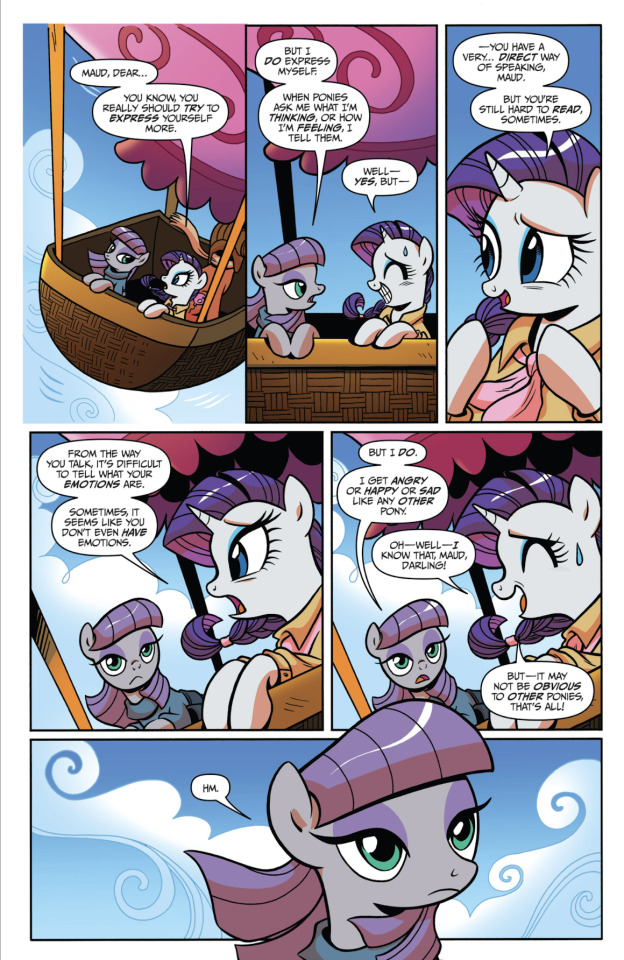
Later on just as they're about to get close to the caves, Buried Treasure ends up burning a bridge they need to cross (torch and all) which appears to put a stop to their adventure. Rarity states how this doesn't seem to be a big loss as Maud doesn't appear to be upset, and is about to write in her diary, only to accidentally open Maud's diary instead. Maud insists that Rarity should read it, which leads us to the big reveal.


It turns out that Maud does have feelings, she gets emotional about a ton of stuff, she just isn't able to show it physically, but she's able to via writing. This is something I relate to big time. I don't have as much trouble expressing my emotions as Maud does, but at the same time, I often have difficulty expressing my full thoughts and more complex feelings via talking, though in my own head or when I write them out, I suddenly feel a whole lot more comfortable and I'm more easily able to get them out (it's one reason why this essay is a blog post and not a video).

(By the way, in case you're wondering, they do end up getting to the gem caverns first. Maud does this by breaking a hole in the wall. She's very strong.)
Going onto another subject, in 2023 Lauren Faust (the creator of Friendship is Magic) confirmed on Twitter that she created Pinkie Pie with the idea that she would be neurodivergent (more specifically ADHD).

Now while ADHD isn't the same as Autism, the two are often linked, as many people who are diagnosed with one will often be diagnosed with the other. So it's very likely that Pinkie Pie has autism as well. She does have several autistic traits, like misunderstanding more complex things, having a special interest in parties to where she can memorize everyone's birthday amongst several other party related facts, heck, even her occasional bouncing and wiggling around could be seen as a kind of stimming (possible essay for later: "Is Pinkie Sense a form of stimming that can predict the future").

Now there may be a few of you that may say, "But WaggToon, Maud and Pinkie can't both have autism, they're completely different. It doesn't make sense!" To which I say, "Yes it does" because there's more than just one kind of autism. Autism can effect people differently, some people might have difficulty with loud noises, others don't, some people like to follow a specific routine, others like to be more unpredictable, some people are more introverted and quiet, other's are a lot more extroverted and love to be loud and crazy (do those last two sound familiar?).

Maud and Pinkie might not be the only autistic representation here, over the years I've seen several arguments from fans stating that certain characters could be part of the spectrum. Twilight Sparkle because she likes to follow the rules, Starlight Glimmer because she has a special interest in kites, Rainbow Dash because she has trouble paying attention, amongst several others! I could be here all day going over why multiple characters could be considered to be autistic. That's one reason why My Little Pony: Friendship is Magic has such a huge autistic following, because we see ourselves in these characters.

I'm probably closer to a Pinkie Pie than I am a Maud Pie, but I still remember when I first saw Maud in her debut episode, there was just something about her that made me go "Ah yes, this is me. I feel seen."

Happy Autism Acceptance Month everybody. Remember to be like Maud and rock on.

#Autism#autism acceptence month#autism acceptance#Essay#Maud Pie#MLP#MLP FIM#my little pony#my little pony: friendship is magic#Youtube#Autism Awareness Month
265 notes
·
View notes
Text
Posted about British colonial officials in 1860s South India being fascinated by studying geology of Deccan Plateau as both a potential source of material wealth but also as more like intellectual curiosity that allowed them to consider "deep time" and the place of "civilization" in history. And someone shared post, commenting in tags something sort of like "interesting how British Empire could be so focused on rocks."
And really:
Both British imperial power and British popular imagination are tied to "ancient rocks"
British coal and coal-powered engines transformed global ecologies and societies with railroads and factories at the same time that British public became widely aware of dinosaurs, extinct Pleistocene megafauna, the vast scale of deep time, geology, and uniformitarian Earth systems. Then British anthropology, Egyptomania, archaeology, etc., were implicated in professionalization of sciences and ideas of primitivsm/racial hierarchy. Then British extraction of liquid fossil fuels instantiated expansion of petroleum products. Victorian popular culture had a penchant for contemplating death, decay, deep past, civilizational collapse, classical antiquity. So there's a simultaneous fixation on both temporality and materiality. Which both involve "earth."
-
Consider:
Coal. How the mining of "ancient rock" (300-million-year-old Carboniferous) and coal-burning probably strongly propelled Britain (tied also to enclosure laws and Caribbean slave profits reinvested in ascendant financial/insurance institutions) to the "first" industrialization around 1830, helping cement its global hegemony and setting a blueprint for European/US industry. How burning that ancient rock "unlocked steam power" for Britain and facilitated the rapid expansion of railroad networks after the first public steam railway in 1825 (steam engines then let Britain reach and extract resources from hinterlands) while the rock also powered textile mills after the 1830s (putting poorer Britons to work in mills and factories while "Poor Laws" were put into effect outlawing "vagrancy" and "joblessness") which reshaped "the countryside" in Britain and reshaped global ecologies and labor regimes. Provincial realist novels and other literature reflect anxiety about this ecological/social transition. Even later Victorian novels and fin de siecle commentaries hint how coal and industrialization invoke temporality more directly, in that the engines and technologies provoke rhetoric and discourses about exponential growth, linear progress, and dazzling future horizons.
Fossils of Pleistocene megafauna: How an extinct Mastodon was displayed at Pall Mall in London in 1802. And how William Conybeare's discovery/description of coal-bearing rock in Britain led him to name "the Carboniferous period" in 1822, but it wasn't just coal power that this event inspired. in the very same year, Conybeare described the remains of extinct Pleistocene hyenas at Kirkdale Cave in Britain. The promotion of this discovery of Ice Age hyenas gave many Britons for the first time an awareness of deep past and obsession with Creatures. But the promotion also brought spectacle, public display, poetics, and marketing into natural history like "edu-tainment," a "poetics of popular science." This took place in the context of the rapid rise of British mass-market print media. Geological verse, Victorian novels, and cheap miscellanies reflect anxiety about this temporality and natural history.
Geology as a discipline: How the 1830 publishing of Lyell's monumentally significant Principles of Geology, directly inspired after he observed British ancient rock formations at Isle of Arran, completely changed European/US understanding of deep time and geology and the scale of Earth systems (uniformity principle), which made people wonder about linear notions of history and whether empires/societies can survive forever in such vast time scales.
Dinosaur fossils: How the "first dinosaur sculptures in the world" (dinosaur fossils reminiscent of ancient rock?) were reconstructed and put on display by Britain in 1854 at Crystal Palace in London following "the Great Exhibition," an event which set the model for future exhibitions and started the global craze for "world's fairs" and expositions showcasing imperial/industrial power for decades (the model for Chicago's Columbian Exposition of 1893, Paris event of 1900, St. Louis event of 1904, and beyond).
Soil mapping: How "ancient rock" was entangled with one of the most significant scientific projects of all-time, Britain's "The Great Trigonometric Survey of India" in 1802, undertaken to survey and record soil types across South Asia. After the resistance of the leaders of Mysore had finally been defeated, the subcontinent was vulnerable to consolidated British colonial power, and surveys were ordered immediately. The mapping of acreage for tax administration by the East India Company would remake societies with bordered property, contracted ownership, tax/wealth extraction. But the Survey also let Britain map soil for purposes of monoculture agriculture planning. Britain then used geology/soil as potential indicators of biological essentialism that equated "ancient" Gonds of India or "ancient" Aboriginal peoples of Australia with primitivism. Adventure stories and sportsmen's pulp magazines reflect anxiety about these cultural and geographical frontiers.
Diamonds: How the discovery of ancient rock (diamonds, from tens of millions of years old kimberlite) in the Kimberly (South Africa) rocketed Britain to more power when their colonial commissioners took possession in 1871, giving Britain a foothold and paving the way for Cecil Rhodes to amass astonishing wealth while completely remaking social institutions, labor regimes, and environments in southern Africa, giving Britain so much profit from diamonds that in 1882 Kimberly was only the second city on the whole planet to install electric street lighting.
Egyptomania: How British archaeologists digging around in ancient rock of their vassal/colony of Egypt, especially the tens of thousands of ancient Egyptian artifacts that they collected between 1880 and 1890, contributed to a craze for classical antiquity and a fixation on the ancient Mediterranean and mummies.
Victorian death fascination: How British archaeologists interacting with ancient rock in Southwest Asia (Mesopotamia, Levant) coupled with the Egyptomania also strongly influenced Late Victorian obsessions with death, decay, the occult, millennarian dates, and civilizational collapse which continued to influence culture, fashion, historicity, and narrativizing in Europe/US for years. Perhaps they wondered: "If Ur could fall, if Thebes could fall, if Mycenae could fall, if ROME could fall, then how could our civilization based in fair London survive such vast eons of time and such strong geological and environmental forces?"
Liquid fossil fuels: How "ancient rock" yielded liquid fossil that was extracted by British industrialsits when the first test oil wells were dug at "the Black Spot" in Borneo in 1896 which led to creation of Shell Oil company in 1897 led by a British director who was fascinated with ancient fossils. Followed then the global expansion of combustion engines, oil lubricants, and networks of imperial infrastructure to extract and refine oil. And how British tinkering with "ancient rock" of Persia and Southwest Asia led to the bolstering of a "Middle East" oil industry; the Anglo-Persian Oil Company was founded in 1909, giving Britain yet more geopolitical leverage in the region; the company would later become BP, one of the biggest and most profitable corporations to ever exist.
-
So the immaterial imaginaries of place/space and time (frontiers, the exotic/foreign, the tropical/Orient, ascent/decay, civilization/savagery, deep past/future horizons) justify or organize or pre-empt or service the material dispossession and accumulation.
British Empire transformed Earth and earth. Both materially/physically and immaterially/imaginatively.
400 notes
·
View notes
Text
"The world is betting heavily on carbon capture — a term that refers to various techniques to stop carbon pollution from being released during industrial processes, or removing existing carbon from the atmosphere, to then lock it up permanently.
The practice is not free of controversy, with some arguing that carbon capture is expensive, unproven and can serve as a distraction from actually reducing carbon emissions. But it is a fast-growing reality: there are at least 628 carbon capture and storage projects in the pipeline around the world, with a 60% year-on-year increase, according to the latest report from the Global CCS (Carbon Capture and Storage) Institute. The market size was just over $3.5 billion in 2024, but is projected to grow to $14.5 billion by 2032, according to Fortune Business Insights.
Perhaps the most ambitious — and the most expensive — type of carbon capture involves removing carbon dioxide (CO2) directly from the air, although there are just a few such facilities currently in operation worldwide. Some scientists believe that a better option would be to capture carbon from seawater rather than air, because the ocean is the planet’s largest carbon sink, absorbing 25% of all carbon dioxide emissions.
In the UK, where the government in 2023 announced up to £20 billion ($26.7 billion) in funding to support carbon capture, one such project has taken shape near the English Channel. Called SeaCURE, it aims to find out if sea carbon capture actually works, and if it can be competitive with its air counterpart.
“The reason why sea water holds so much carbon is that when you put CO2 into the water, 99% of it becomes other forms of dissolved carbon that don’t exchange with the atmosphere,” says Paul Halloran, a professor of Ocean and Climate Science at the University of Exeter, who leads the SeaCURE team.
“But it also means it’s very straightforward to take that carbon out of the water.”
Pilot plant
SeaCURE started building a pilot plant about a year ago, at the Weymouth Sea Life Centre on the southern coast of England. Operational for the past few months, it is designed to process 3,000 liters of seawater per minute and remove an estimated 100 tons of CO2 per year.
“We wanted to test the technology in the real environment with real sea water, to identify what problems you hit,” says Halloran, adding that working at a large public aquarium helps because it already has infrastructure to extract seawater and then discharge it back into the ocean.
The carbon that is naturally dissolved in the seawater can be easily converted to CO2 by slightly increasing the acidity of the water. To make it come out, the water is trickled over a large surface area with air blowing over it. “In that process, we can constrict over 90% of the carbon out of that water,” Halloran says.
The CO2 that is extracted from the water is run through a purification process that uses activated carbon in the form of charred coconut husks, and is then ready to be stored. In a scaled up system, it would be fed into geological CO2 storage. Before the water is released, its acidity is restored to normal levels, making it ready to absorb more carbon dioxide from the air.
“This discharged water that now has very low carbon concentrations needs to refill it, so it’s just trying to suck CO2 from anywhere, and it sucks it from the atmosphere,” says Halloran. “A simple analogy is that we’re squeezing out a sponge and putting it back.”
While more tests are needed to understand the full potential of the technology, Halloran admits that it doesn’t “blow direct air capture out the water in terms of the energy costs,” and there are other challenges such as having to remove impurities from the water before releasing it, as well as the potential impact on ecosystems. But, he adds, all carbon capture technologies incur high costs in building plants and infrastructure, and using seawater has one clear advantage: It has a much higher concentration of carbon than air does, “so you should be able to really reduce the capital costs involved in building the plants.”
Mitigating impacts
One major concern with any system that captures carbon from seawater is the impact of the discharged water on marine ecosystems. Guy Hooper, a PhD researcher at the University of Exeter, who’s working on this issue at the SeaCURE site, says that low-carbon seawater is released in such small quantities that it is unlikely to have any effect on the marine environment, because it dilutes extremely quickly.
However, that doesn’t mean that SeaCURE is automatically safe. “To understand how a scaled-up version of SeaCURE might affect the marine environment, we have been conducting experiments to measure how marine organisms respond to low-carbon seawater,” he adds. “Initial results suggest that some marine organisms, such as plankton and mussels, may be affected when exposed to low-carbon seawater.”
To mitigate potential impacts, the seawater can be “pre-diluted” before releasing it into the marine environment, but Hooper warns that a SeaCURE system should not be deployed near any sensitive marine habitats.
There is rising interest in carbon capture from seawater — also known as Direct Ocean Capture or DOC — and several startups are operating in the field. Among them is Captura, a spin off from the California Institute of Technology that is working on a pilot project in Hawaii, and Amsterdam-based Brineworks, which says that its method is more cost-effective than air carbon capture.
According to Stuart Haszeldine, a professor of Carbon Capture and Storage at the University of Edinburgh, who’s not involved with SeaCURE, although the initiative appears to be more energy efficient than current air capture pilot tests, a full-scale system will require a supply of renewable energy and permanent storage of CO2 by compressing it to become a liquid and then injecting it into porous rocks deep underground.
He says the next challenge is for SeaCURE to scale up and “to operate for longer to prove it can capture millions of tons of CO2 each year.”
But he believes there is huge potential in recapturing carbon from ocean water. “Total carbon in seawater is about 50 times that in the atmosphere, and carbon can be resident in seawater for tens of thousands of years, causing acidification which damages the plankton and coral reef ecosystems. Removing carbon from the ocean is a giant task, but essential if the consequences of climate change are to be controlled,” he says."
-via CNN, April 29, 2025
#carbon capture#environment#co2#emissions#carbon emissions#ocean#seawater#uk#united kingdom#europe#climate news#climate action#good news#hope
227 notes
·
View notes
Text
tactics and tea ; zhongli



oneshot & fluff ↪ in which lumine watches zhongli and y/n’s “date” devolve into a tea-fueled chess match and questions everything about their relationship. ↷ zhongli ; genshin impact
↳ an order of flat white from @sailorstar9 in the comeback cafe event !

LIYUE HARBOR SPARKLED beneath the early evening sun, the scent of sea salt and grilled skewers drifting lazily through the air. The bustling pier was alive with chatter, the sounds of a marketplace winding down.
And in the most romantic location imaginable—a shaded tea pavilion overlooking the harbor—sat Zhongli and Y/n.
Playing chess.
Again.
Lumine blinked once. Then twice.
Then stared at the porcelain teacup in her hand like maybe it could make this make sense.
“You call that a date?” she deadpanned, eyes flicking from the chessboard to Zhongli—who was currently contemplating his next move like the fate of the Archons depended on it.
Across from him, Y/n sipped her osmanthus tea with the satisfaction of a woman who’d baited her boyfriend into a trap four moves ago.
“Technically, yes,” Y/n hummed. “We’re spending quality time together.”
Zhongli nodded solemnly. “Strategic intimacy.”
“That’s not a thing,” Lumine muttered, deeply concerned.
Y/n leaned across the board with a grin. “You just don’t understand the art of tactical romance.”
“You’re playing chess.”
“Exactly.”
Zhongli moved his knight. “Check.”
“Ha!” Y/n slammed her palm down triumphantly. “I wanted you to do that. Foolish mortal.”
Lumine gawked. “You’re both mortals!”
Zhongli arched an elegant brow. “Technically, I am not.”
“That’s not the point!”
Y/n moved her queen like she was defusing a bomb. “Boom. Checkmate in three moves.”
Zhongli’s eyes sparkled with genuine delight. “Ah. A clever feint. Most impressive, my dear.”
Y/n flushed, cheeks warming. “What can I say? I’m brilliant and beautiful.”
He smiled, warm and utterly lovestruck. “Indeed. I could not have chosen a finer partner in all of Teyvat.”
Lumine opened her mouth. Closed it. Pinched the bridge of her nose.
“You two are the strangest couple I’ve ever met.”
“Thank you.”
“That wasn’t a compliment.”
Zhongli refilled Y/n’s teacup with the utmost reverence, like she was royalty.
Y/n kicked her legs a little under the table, trying not to beam too hard.
Lumine stared at them—her traveler instincts fully convinced she was witnessing some kind of ancient ritual disguised as a date.
Then y/n turned to her, still grinning. “For the record, our first date was at a rock museum.”
“Of course it was,” Lumine muttered.
“We played Geo Guessr.”
“That’s not real.”
“I won. He proposed an hour later.”
Zhongli coughed politely into his fist. “To clarify, it was a theoretical proposal. In which I offered her my companionship until the erosion of memory.”
“…what does that even mean?”
“Romance,” y/n said, completely serious, “but with extra steps and a geological time scale.”
Lumine stared into her tea again. Maybe she was the weird one.
Y/n leaned back, resting her chin in her hand as Zhongli reset the board. “You staying for the next round?”
Lumine got up. “I’m going to go find Aether and beg him to punch me so I know this isn’t a fever dream.”
Zhongli looked up serenely. “We shall save you a seat for mahjong night.”
Lumine walked away faster.
Y/n turned to Zhongli with a dreamy sigh. “Do you think she’s jealous of our intellectual intimacy?”
“Perhaps,” he said, moving a pawn with the gravitas of a man who once wrote an 87-volume treaty on salt.
They smiled at each other.
And if their hands accidentally touched over the chessboard—well. That was just checkmate for the heart.

© eriace ;; don’t repost my works.
#genshin impact x y/n#genshin impact x you#genshin impact x reader#genshin impact#genshin x reader#genshin zhongli#zhongli#morax#zhongli x reader
127 notes
·
View notes
Text
The Report
Winter: General Ironwood, I wish to make a report about my joint mission with, Jaune Arc on a, C Class seek, and destroy mission.
Ironwood: Ahh good. I was going to ask you to report on that mission. You rarely take any missions from the quest board since becoming my second. Any missions you do take, are missions I sanctioned you to take, along with the rest of your specialist members. So, tell me, Specialist Schnee, why did you decided to take on this mission, and with Jaune Arc at that?
Winter: At once, Sir.
Winter: I was made aware of the mission particulars whilst I was playing a game of chess with, Mr. Arc. He informed me that he had never heard of the target before reading the mission request. Upon doing research about the target, a C Class Grimm threat called a, Karniviar, and more research about the, Grimm's last know location, he deemed this quest to be a, B, or potential A Class threat.
Ironwood: He deemed it to be a potential, A Class threat? What made him think so?
Winter: Understanding the potential threat of a, Karniciar alone more than grants it the ranking of a, C to low, B Class threat. It's bone platting requires high caliber AP rounds to pierce. It's claws posse the capabilities to tear through reinforced fencing with ease. It possess a bight force of an estimated 20,000 psi, making it capable of biting a, Knight in two with relative ease. All the while it's tail spike posses the potential to pierce through the armour platting of one of our, Paladins.
Ironwood: Fascinating... what level of it's evolution is this, Grimm categorized as?
Winter: Unknown, Sir. I did my own research before joining, Mr. Arc on this mission, and from what meager reports there are, I lean fiund myself agreeing that this is an, egg based, Grimm.
Ironwood: Egg?
Winter: Yes, the first stage of this, Grimm begins in an egg stage where it remains underground until it matures, and hatches into a fully formed, Karniviar. I would estimate this this new born stage to be at least in the, Gamma Classification.
Ironwood: Gamma? If it was already like this, I would hate to see it in the, Beta Class of it's evolutionary development, let alone in it's, Alpha form. So, this is why, Mr. Arc saw it as a potential, A Class threat.
Winter: Negative, Sir.
Ironwood: Beg pardon?
Winter: Mr. Arc did not see the, Karniviar as a possible, A Class threat for those possibilities, Sir. He saw it as a possible, A Class threat due to it's geological location, and it's potential harm it could inflict upon, Atlas, and Mantle.
Ironwood: 'Because of where it was located, and it's potential harm it could inflict to the people of, Atlas, and Mantle?' I must say you have me most intrigued, Specialist Schnee. Please, continue.
Winter: Thank you, Sir. During, Mr. Arc's research he found out that the, Karniviar was located near a fishing town called, Breakers Peak. This town itself provides sixty percent of, Atlas, and Mantles raw supply of fish.
Ironwood: Sixty percent of, Mantle, and Atlas fish supply? Ahh I see... He classified it as a potential, A Class threat because if it attacked this fishing town it would disrupt the amount of food entering, Atlas, and Mantle, didn't he.
Winter: Partly, Sir. Mr. Arc theorized that if this, Grimm attacked, Breakers Peak, and even if it only managed to reduced the towns fishing capabilities by thirty percent, the consequences could be quite dire. If the price of fish goes up, the price of any food produced items with fish goes up as well. Resulting in an domino effect where the rise in prince of one item leads to the rise of price in another. And, if food prices continue to rise people would start to get worried, and as the more people get worried...
Ironwood: The Grimm become more active. And thus, the result of leaving this, Grimm alive leads to potential devastation to, Atlas, and Mantle without it even having to attack us directly.
Winter: Mr. Arc's thoughts came to the same conclusion as well, Sir.
Ironwood: No wonder he saw it as a potential, A Class threat... His thought process taking into the account not just the, Grimm itself, but where it was seen, and the possible threats it could have in that given area. Hmmm... I think we need to adopt such a train of thought when assigning threat levels to missions.
Winter: My thoughts exactly, General. I have already started a rudimentary outline of a possible new way of classifying , Grimm threats based upon. Mr. Arc's thought process.
Ironwood: Very good. Hand that to me for my review once it is completed.
Winter: Of course, Sir.
Ironwood: So was this the reason why you accompanied, Mr. Arc on this mission?
Winter: It was one of three reasons, Sir.
Ironwood: One reason? What were the other reasons?
Winter: When, Mr. Arc told me about this mission, we where playing a game of chess. A game where... he thoroughly defeated me... Effortlessly at the...
Ironwood: Effortlessly? For you to say that is quite the complement, if I am not mistaken, you are considered a grandmaster at chess.
Winter: I am considered a grandmaster at chess, but after, Mr. Arc thoroughly defeated me, I feel like a novice at chess once again.
Ironwood: What did he do?
Winter: I don't know how he did it precisely, but to summarize: Psychological warfare.
Ironwood: Psychological warfare? Hmmm... I didn't take, Mr. Arc as one who would apply such tactics in a fight. How did he do it?
Winter: I was focusing on the fact that, Mr. Arc hadn't moved his queen, thinking that his plan was to move his other pieces into the perfect position so he could suddenly spring a trap, deploy his queen, and go for the kill. But, in actuality his plan was to make me think that he had some sort of grand plan with his queen as the focal point of it. However, Mr. Arc had no intention whatsoever of using his queen, and was instead focusing on getting my other pieces into the perfect position. And, then go for the kill.
Ironwood: His entire strategy was based on the idea that he was going to us his queen, the most valuable piece on the board. When in fact, he had no intention of using his queen from the begining?
Winter: Correct, in fact I was so focused on his queen I never realized that he in fact, never physically touched his queen to begin with. It was because of this unexpected strategy he implemented, I was curious to see how he planned to deal with the a beast such as the, Karniviar all on his own. So, I asked to accompany him.
Ironwood: I see, how did he deal with the, Karniviar.
Winter: When we arrived at the town he asked the locals where the, Karniviar was last seen, Jaune then went to the area to explore it. When we arrived at the area it was last seen, an old abandoned, Dust mine. Jaune spent some time watching the monster from a distance where he finally implemented his plan.
Ironwood: Which was?
Winter: Mr. Arc came closer to the, Karniviar, the beast turned to roar at him, and in that instant the, Karniviar roared, Mr. Arc threw one of his portable shield walls into it's mouth. When it went done the creatures mouth he activated it, and broke the creatures neck from the inside. The creature died within seconds, and started to fade away before it even hit the ground. From start to finish, it only took a minute for, Mr. Arc to defeat a C Class threat.
Ironwood: Seriously?
Winter: Yes, I have video of the event to prove it.
Ironwood: Show me.
Ironwood: ...
Ironwood: Impressive... that was most impressive.
Winter: I assumed, Mr. Arc would stabbing the creature between it's armour plates, but as, Mr. Arc said: 'There are plenty of chinks in its armour to exploit.'
Ironwood: I would have attacked the creature between the armour plating, or trying to break the platting. I must confess, I wouldn't have thought about going down it's throat. I can see why you decided to join, Mr. Arc on this mission. This was quite an informative mission you decided to take on.
Winter: That... That wasn't entirely why I joined him on this mission, Sir...
Ironwood: Ahh, the third reason why you joined him. Tell me, what was this third reason?
Winter: I am... I am worried about, Mr... I am worried about, Jaune's mental stability, Sir...
Ironwood: His mental stability?
Winter: As a result of his social isolation because of his peers. Jaune has developed a habit of talking to himself; He denies that this has been happening of course, but on the few times I have caught him talking to himself, his eyes linger to the side for a bit before denying it.
Winter: I am worried he will harm himself, directly, or indirectly because of this. So, Sir, I request permission to be assigned to any joint missions, Mr. Arc takes. So, I can ensure his mental stability.
Ironwood: ...
Ironwood: Permission granted. Also try, and see if we can get him in for a psychiatric evaluation as well. In fact, put all of, Team RWBY, and the other members of, Team JNPR into this as well. This is standard practice anyway among veteran, Hunters. These kids have been through quite enough as it is.
Winter: Thank you, Sir. I will do so at once.
Ironwood: Oh, and, Specialist Schnee?
Winter: Sir?
Ironwood: My condolences concerning the loss of your father.
Winter: T-Thank you, Sir... It was so sudden, I have no words for this sudden, terrible incident that has happened to my family. It's such a shame that he was taken from us...
Ironwood: ...
Winter: ...
Ironwood: That was a terrible performance, Specialist Schnee.
Winter: Did you honestly expect me to be sad after that monsters death, Sir?
Ironwood: No, not at all. I just thought I should say it, it was polite to offer my condolences for the loss of a family member. I certainly didn't take a celebratory drink at the news of his passing. No, nothing like that happened at all.
Winter: Of course, nothing happened at all.
Ironwood: Well then, is that all, Specialist?
Winter: Yes, Sir.
Ironwood: You're dismissed.
Winter: Sir!
241 notes
·
View notes
Text



🌌A silkvine (lat. Períploca gráeca). A creeper-like plant that belongs to the relics of the Black Sea and the Caucasus.
Relict species are typically those that have survived in a specific region since the time of ancient flora or fauna from past geological eras. Because they have reached the present day with little to no change, scientists can gain a better understanding of the history of life on Earth and the processes of evolution🌿
🌌Обво́йник греческий (лат. Períploca gráeca). Лиановидное растение, которое относят к реликтам Черного моря и Кавказа.
Как правило, реликтами называют виды, сохранившиеся в конкретном регионе с времён флоры или фауны прошлых геологических эпох. Благодаря тому, что они дожили до наших дней практически без изменений, учёные могут лучше понять историю развития жизни на Земле и процессы эволюции🌿
#noseysilverfox#photography#nature#naturecore#wildlife photography#photography on tumblr#interesting facts#plant photography#plantblr#purple flowers#flowers#photographers on tumblr#evening#aesthetics#фотоблог#природа#фотографии природы#турумбочка#русский tumblr#растения#цветы#вечер#фотография#интересные факты#дикая природа#flora and fauna#цветение
107 notes
·
View notes
Text
The Irritator and the colonial culture: The importance of fossil repatriation
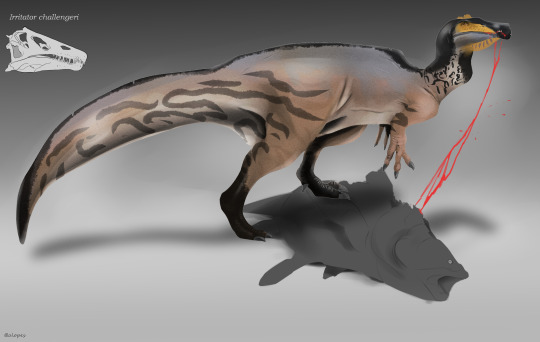
The Irritator and the colonial culture: The importance of fossil repatriation
Unearthing a new specimen may be one of the wonders of working with palaeontology, allowing us to grasp a piece of the history on this planet.
Now, a good amount of those 'time machines' are illegally commercialised, compromising the light it can give on reconstructing the geologic understanding of the evolution of life on our planet. But this illegality does not arise out of the blue: most of it is a product of a still-existing culture of domination and culture washing; the feeling that some have the right to usurp national heritages such as fossils. In Brazil, it is almost a conundrum to have a good amount of specimens being "relocated" to other territories in very shady ways, only to be found out when the said-so paper is finally published (a lot of those specimens may be forgotten in collections storages for decades). This time, the fossil who needs a new passport and is not-so-unknown is the Irritator challengeri.
Repatriating a fossil has not only a scientific importance, it also recognizes a whole cultural scope regarding the fossil's original location, reaffirming the significance of a country's geologic history. It also brings to the table all the legal problematics that paleontology faces today.
67 notes
·
View notes
Text
New Vegas Divide and Big MT Locations
A lot of discussions I find on the matter tend to ultimately be met with the answer of, "It's a fake place somewhere in Death Valley, it doesn't matter exactly where". I can understand not needing this information to enjoy the story, but unfortunately, I'm roleplaying a prequel set in 2276 so I want some goddamn specifics 💅
SO. My own speculation on The Divide's more precise location below the cut. Apologies if anyone has supplied this theory before, I got a little tired of browsing reddit threads full of incurious wiki-thumpers.
(tl;dr it's a developed Fort Irwin)
The Divide and the named places in it obviously don't correlate as directly with real locations like the rest of the game, but this makes sense. In a differing timeline where the nuclear arms race seems to have only shifted in players, not ethics, it's easy to imagine that the area surrounding desert military operations and nuclear development sites would grow in importance (I similarly have mentioned Los Alamos being a much bigger city in our RP for the same reason). The Mojave was a hub for nuclear R&D and even today houses one of our warheads, of course it would boom (pun unavoidable). So the first thing I did was ignore cities, even "Ashton". A location named Ashton does exist further north beyond the Nevada border, but nothing about it geographically matches what we interact with in game.
Instead, I thought about the geography itself. What we know about the Divide is that the detonations there made CA-127 unusable, forcing NCR supply chains trying to reach Hoover Dam to enter via the 15 and Mojave Outpost.

We also know it was east of established NCR territory, west of the main NV game map, and north of the 15.

This means its radius is limited to something like this.

Looking at the overlay, and knowing that the "default story" courier had been for some time delivering supplies between the established NCR and Ashton/Hopeville, their route taking them from The Hub (formerly Lancaster), the industrial and trade center of New California, and this new city makes the most sense.

(As an aside, I have to say that I'm very sorry to classic players upset about the map retcon, because that damn geography doesn't even match what the text implies. The Necropolis is Barstow, not Bakersfield?? Anyway.)
Further evidence that the courier's route brought them from the Hub is a note by a merchant from there who appears to have found their old route after the bombs...

... and Nash explaining that the Courier was initially hired at The Hub in the first place, indicating an established presence there.

So we have the general radius. How do we get more specific? What I think a lot of people ignore when trying to pinpoint the area are the quakes set off by the subterranean bombs and the effect they had on the landscape: gaping geological scars that run East-West, indicating a sensitive fault line at this angle.
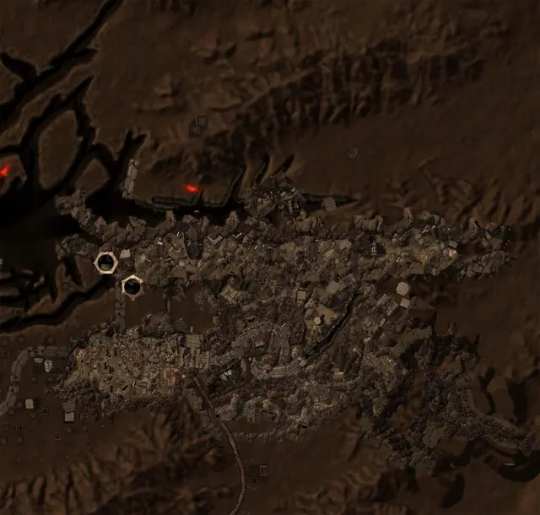

The immediately clear answer to this was the Ridgecrest fault.
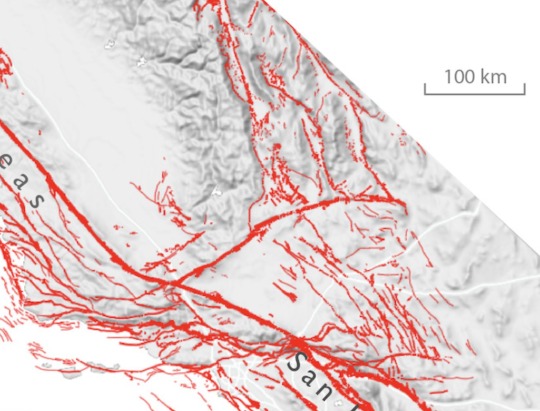

Okay, so we have a good candidate for a fault line. What sits below it? In our timeline, the remote Fort Irwin and its surrounding military desert combat training sites (complete with simulated villages), and the Goldstone site satellite complex. If you were going to use existing infrastructure as building blocks for new and grander development in this region, the roads, electricity, water treatment, and radio towers here would be the ideal choice. Let's see if it lines up.

You know what? I'll take it. A circular central interchange that branches out through mountainous areas situated just below the Ridgecrest fault. So where does that place Big MT? We know it's south of Hopeville, but it can't interfere with I-15. This necessitates an area of (currently) high elevation with caves below surrounded by darker soil, canyon networks, but an otherwise flat landscape somewhere just south of the Divide radius.
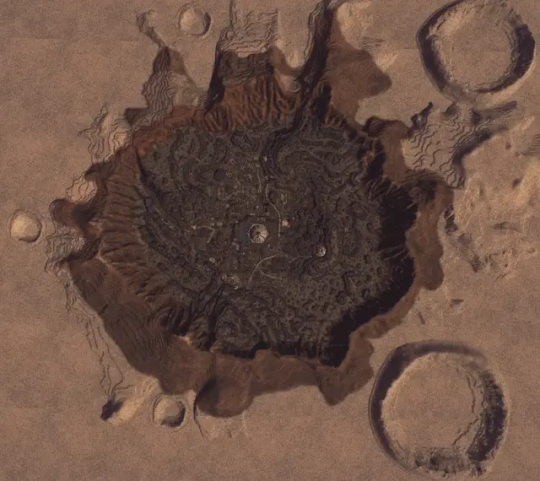
Wouldn't you know, there just happens to be a lone mountain that sits atop an opal mine, which in a different timeline could have very easily been converted into a different excavation project. Opal Mountain, or the Black Mountain Wilderness (unrelated), is a perfect match.

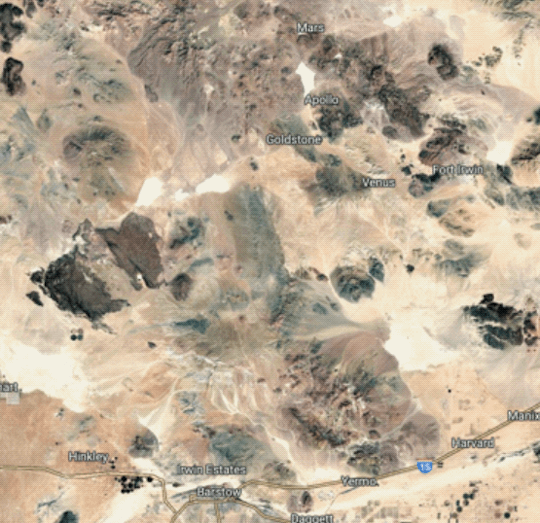
So! This is obviously pure speculation based on me having the specific flavor of autism that brews when one grows up having their own brain fried by 120f weather and residual nuclear fallout. I did this for the purpose of RP, but if anyone finds it useful, yippee etc.
84 notes
·
View notes